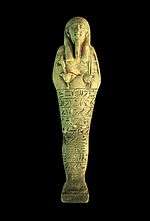Nepherites I
| Nepherites I | |||||||||||||||||||||||||||||||||||||||||||||||||||||||||||||||||||||||||||||||
|---|---|---|---|---|---|---|---|---|---|---|---|---|---|---|---|---|---|---|---|---|---|---|---|---|---|---|---|---|---|---|---|---|---|---|---|---|---|---|---|---|---|---|---|---|---|---|---|---|---|---|---|---|---|---|---|---|---|---|---|---|---|---|---|---|---|---|---|---|---|---|---|---|---|---|---|---|---|---|---|
| Nefaarud I | |||||||||||||||||||||||||||||||||||||||||||||||||||||||||||||||||||||||||||||||
|
Sphinx of pharaoh Nepherites I in the Louvre Museum | |||||||||||||||||||||||||||||||||||||||||||||||||||||||||||||||||||||||||||||||
| Pharaoh | |||||||||||||||||||||||||||||||||||||||||||||||||||||||||||||||||||||||||||||||
| Reign | 398–393 BC (29th Dynasty) | ||||||||||||||||||||||||||||||||||||||||||||||||||||||||||||||||||||||||||||||
| Predecessor | Amyrtaeus | ||||||||||||||||||||||||||||||||||||||||||||||||||||||||||||||||||||||||||||||
| Successor | Psammuthes | ||||||||||||||||||||||||||||||||||||||||||||||||||||||||||||||||||||||||||||||
| |||||||||||||||||||||||||||||||||||||||||||||||||||||||||||||||||||||||||||||||
| Children | Muthis (disputed) | ||||||||||||||||||||||||||||||||||||||||||||||||||||||||||||||||||||||||||||||
| Died | 393 BC [2] | ||||||||||||||||||||||||||||||||||||||||||||||||||||||||||||||||||||||||||||||
| Burial | Mendes | ||||||||||||||||||||||||||||||||||||||||||||||||||||||||||||||||||||||||||||||
King Nepherites I, or Nefaarud I, was an Egyptian pharaoh and founder of the Twenty-ninth dynasty of Egypt. Ruling during the Late Period, he was one of the country's last native rulers. Nepherites was a native of Mendes, where he also made his capital and burial place. He ruled Egypt from 398 BC to 393 BC.[3]
Reign
Nepherites is believed to have won the throne by defeating his predecessor, Amyrtaeus, in open battle,[2] and then executing him at Memphis in 399 BC.[3]
The fact that Nepherites I bears the same Horus name as Psamtik I and the Gold Horus name of Ahmose II is thought to demonstrate that he wanted to associate his rule with an earlier 'golden age' of Egyptian history.[4]
In foreign affairs, he resumed the policy of Egyptian intervention in the Middle East. He supported Sparta in its war against the Persians; the Spartans had conquered Cyprus and Rhodes and making attempts at extending their influence further east. Nepherites supplied the Spartans with 500,000 measures of grain and material for 100 triremes.[5]
Building projects and monuments
There has been evidence of Nepherites's building work found in a number of locations across Egypt[4] A statue of him is known from Buto.[6] Nepherites is attested in Middle and Upper Egypt by a chapel at Akoris and a naos at Sohag among other construction projects at Saqqara and Karnak.[4]
Apart from a small number of ushabtis, the only known representation of Nepherites is a basalt sphinx, now located in the Louvre. The sphinx was known to have been brought to Europe as early as the 16th Century, having adorned a fountain at the Villa Borghese, Rome.[7]
Tomb

A tomb believed to be that of Nepherites was discovered by a joint team from the University of Toronto and the University of Washington in 1992-1993.[8] Possible ownership of the tomb was identified by the presence of a shabti bearing the name of Nepherites I, however definitive proof has not been found.[9] Although still containing funerary objects and a large limestone sarcophagus, the tomb was believed to have been destroyed by the Persians in 343 BC.[8]
Ceramic vessels containing fish specimens and fish-covered stelae have been found on the site of Nepherites's funerary complex. The presence of the fish, often interpreted as votive offerings, could be an indication that the site was previously occupied by a temple of the fish-goddess Hatmehyt.[10]
References
- 1 2 3 4 Clayton, Peter A. Chronicle of the Pharaohs: The Reign-by-Reign Record of the Rulers and Dynasties of Ancient Egypt. p.203 Thames & Hudson. 2006. ISBN 0-500-28628-0
- 1 2 Redford, Donald B. (2004). Excavations at Mendes: The Royal Necropolis 1. Leiden, Germany: Brill. p. 33. ISBN 978-90-04-13674-8.
- 1 2 Dodson, Aidan (2000) [2000]. Monarchs of the Nile (2 ed.). Cairo, Egypt: The American University in Cairo Press. p. 196. ISBN 978-0-9652457-8-4.
- 1 2 3 Shaw, Ian (2000). The Oxford History of Ancient Egypt. Oxford, UK: Oxford University Press. p. 378. ISBN 978-0-19-280458-7.
- ↑ Sweeney, Emmet John (2008). The Ramessides, Medes, and Persians. Ages in Alignment 4. USA: Algora. p. 147. ISBN 978-0-87586-544-7.
- ↑ Gabra, G. (1981). "A lifesize statue of Nepherites I from Buto", SAK 9, pp. 119-23
- ↑ Royal Sphinx with the name of the Pharaoh Achoris. The Louvre. n.d. Retrieved 4 July 2014.
- 1 2 Arnold, Dieter (1999). Temples of the last Pharaohs. Oxford, UK: Oxford University Press. p. 102. ISBN 978-0-19-512633-4.
- ↑ Dodson, Aidan (2009) [1994]. "6". The Canopic Equipment of the Kings of Egypt. Studies in Egyptology. Oxford, UK: Routledge. ISBN 978-0-7103-0460-5.
- ↑ Riggs, Christina, ed. (2012). The Oxford Handbook of Roman Egypt. Oxford, UK: Oxford University Press. p. 39. ISBN 978-0-19-957145-1. Retrieved 4 July 2014.
External links
| Wikimedia Commons has media related to Nepherites I. |
| Preceded by Amyrtaeus |
Pharaoh of Egypt | Succeeded by Psammuthes |

